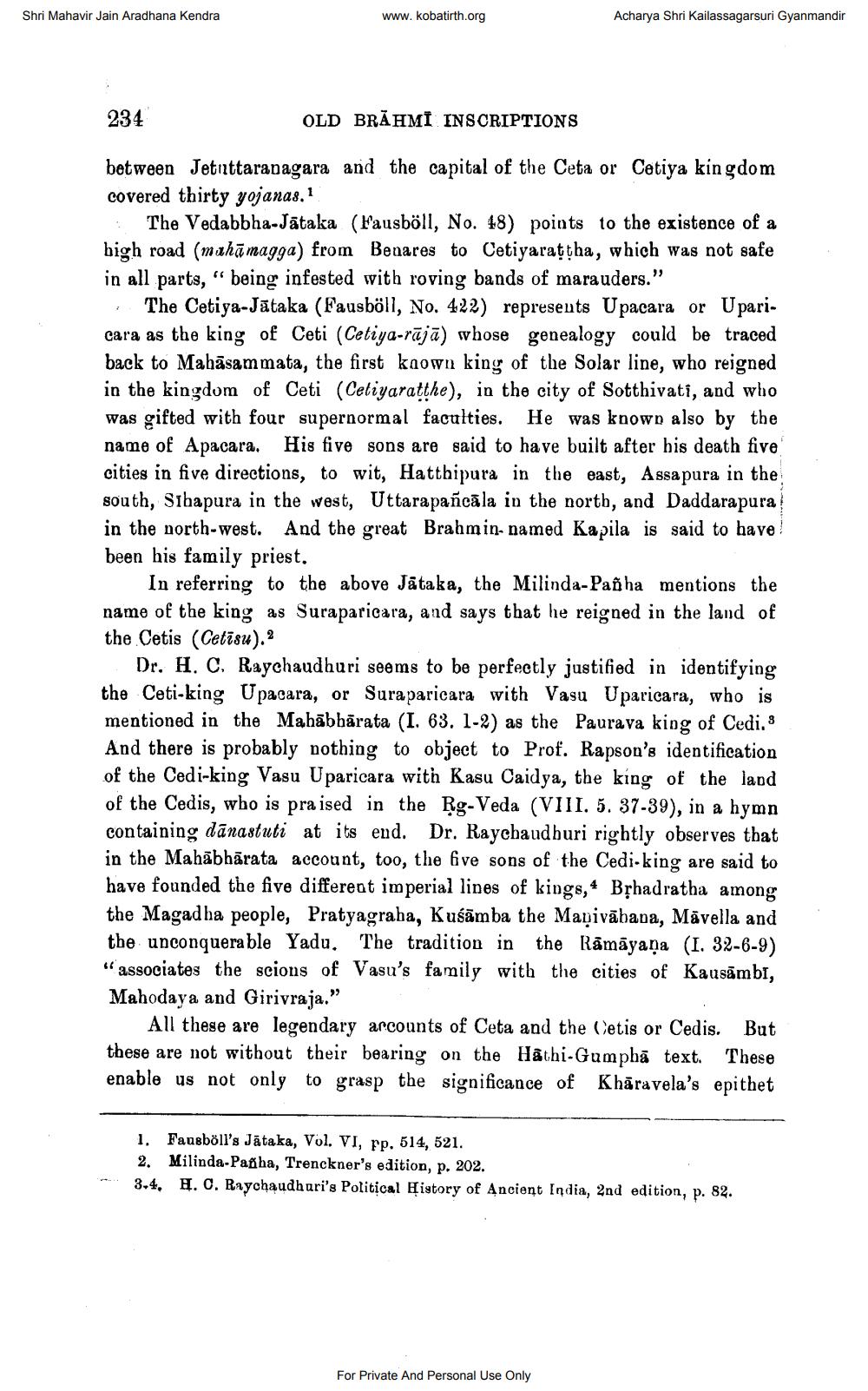________________
Shri Mahavir Jain Aradhana Kendra
www.kobatirth.org
Acharya Shri Kailassagarsuri Gyanmandir
234
OLD BRAHMI INSCRIPTIONS
between Jetiittaranagara and the capital of the Ceta or Catiya kingdom covered thirty yojanas.1
The Vedabbha-Jātaka (Fausböll, No. 48) points to the existence of a bigh road (mahāmagga) from Benares to Cetiyarattha, which was not safe in all parts, " being infested with roving bands of marauders.”
The Cetiya-Jataka (Fausböll, No. 422) represents Upacara or Uparicara as the king of Ceti (Cetiya-rājā) whose genealogy could be traced back to Mahāsammata, the first kaown king of the Solar line, who reigned in the kingdom of Ceti (Cetiyaratthe), in the city of Sotthivati, and who was gifted with four supernormal faculties. He was known also by the name of Apacara. His five sons are said to have built after his death five cities in five directions, to wit, Hatthipura in the east, Assa pura in the south, Sihapura in the west, Uttarapancāla in the north, and Daddarapura in the north-west. And the great Brahmin named Kapila is said to have been his family priest.
In referring to the above Jätaka, the Milinda-Pað ha mentions the name of the king as Suraparicara, and says that he reigned in the land of the Cetis (Cetīsu).
Dr. H. C. Raychaudhuri seems to be perfectly justified in identifying the Ceti-king Upacara, or Suraparicara with Vasu Uparicara, who is mentioned in the Mahābhārata (I. 63. 1-2) as the Paurava king of Cedi. And there is probably nothing to object to Prof. Rapson's identification of the Cedi-king Vasu Uparicara with Kasu Caidya, the king of the land of the Cedis, who is pra ised in the Rg-Veda (VIII. 5. 37-39), in a hymn containing dānastuti at its end. Dr. Raychaudhuri rightly observes that in the Mahābhārata account, too, the five sons of the Cedi-king are said to have founded the five different imperial lines of kings, 4 Bịhadratha among the Magadha people, Pratyagraha, Kuśāmba the Maņivābava, Māvella and the unconquerable Yadu. The tradition in the Rāmāyana (I. 32-6-9) "'associates the scions of Vasu's family with the cities of Kausāmbr, Mahodaya and Girivraja."
All these are legendary arcounts of Ceta and the Cetis or Cedis. But these are not without their bearing on the Hathi-Gumphā text. These enable us not only to grasp the significance of Khāravela's epithet
1. Fausböll's Jặtaka, Vol, VI, pp. 514, 521. 2. Milinda-Papiha, Trenckner's edition, p. 202. 3.4. H.C. Raychaudhuri's Political History of Ancient India, 2nd edition, p. 82.
For Private And Personal Use Only




